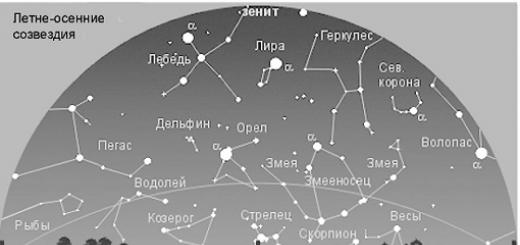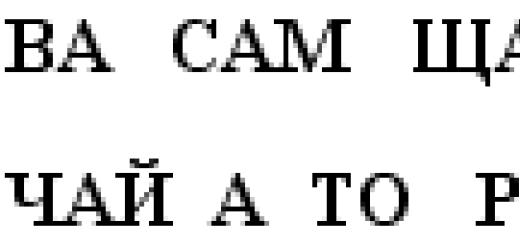When you start learning English, the first thing you encounter is the English alphabet (english alphabet [ˈalfəbɛt]). Writing English letters is not something completely new even at the very initial stage of learning, because any modern person daily encounters English letters on a computer and telephone keyboard. Yes, and English words are found at every step: in advertising, on the labels of various goods, in shop windows.
Article navigation
But while the letters seem familiar, pronouncing them correctly in English is sometimes difficult, even for those who speak English tolerably well. Everyone is familiar with the situation when you need to spell an English word - for example, to dictate an email address or a website name. This is where the wonderful names begin: i - “like a stick with a dot”, s - “like a dollar”, q - “where is the Russian th”.
English alphabet with Russian pronunciation, transcription and voice acting
The English alphabet with Russian pronunciation is only for the very beginners. In the future, when you get acquainted with the rules of reading English and learn new words, you will need to study transcription. It is used in all dictionaries, and if you know it, it will once and for all remove the problem of the correct pronunciation of new words for you. We advise at this stage to compare the transcription icons in square brackets with the Russian equivalent. Perhaps, in these short examples, you will remember some of the ratios of English and Russian sounds.
Below is a table showing the English alphabet with transcription and Russian pronunciation. Notice how the uppercase and lowercase letters look.
← Move the table to the left to view it in full
|
Letter |
Listen |
Transcription |
Russian pronunciation |
|||||||||||||||||||||||||||||||||||||||||||||||||||||||||||||||||||||||||||
Below, you can listen to all the letters of the English alphabet at once:
Alphabet Trainer
Choose the letter that matches its pronunciation.
English alphabet cards
Very effective cards of the English alphabet in its study. Bright and large letters will be easier to remember. See for yourself:
Such cards can be made independently, for example, according to the above sample. Next, print, cut out the letters and arrange them in the correct sequence.
For children, on the cards of the English alphabet, you can depict animals in addition to the letters in order to immediately memorize new words, and the learning process was not boring.
Features of some letters of the English alphabet.
In the English alphabet 26 letters: 20 consonants and 6 vowels.
The vowels are A, E, I, O, U, Y.
There are a few letters in English that we want to pay special attention to because they have certain features that need to be taken into account when learning the alphabet.
- The letter Y in English can be read as a vowel and as a consonant. For example, in the word “yes” it is a consonant sound [j] (th), and in the word “many” it is a vowel sound [i] (and).
- Consonants in words, as a rule, convey only one sound. The letter X is an exception. It is transmitted immediately by two sounds - [ ks ] (ks).
- The letter Z in the alphabet is read differently in the British and American versions (as you probably already noticed in the table). The British version is (zed), the American version is (zi).
- The pronunciation of the letter R is also different. British version - (a), American version - (ar).
To make sure that you pronounce the English letters correctly, we recommend that you not only look at them and read (using transcription or the Russian version), but also listen. To do this, we advise you to find and listen to ABC-song. This song is usually used when teaching children the alphabet, but it can also be useful for adults. ABC-song is very popular in teaching, it exists in various variations. If you sing it with the announcer several times, you can not only check the correct pronunciation of the letters, but also easily remember the alphabet along with the melody.
Listen to a song about the English alphabet:
A few words about spelling
So, we learned the alphabet of the English language. We know how English letters are pronounced individually. But turning to the rules of reading, you will immediately see that many letters in different combinations are read in a completely different way. A reasonable question arises - as the cat Matroskin would say - what is the use of memorizing the alphabet? In fact, there are practical benefits.
The point here is not the ability to tell the alphabet from beginning to end, but the ability to easily spell any English word. This skill is necessary when you need to write down English names under dictation. If you need English for work, this skill can be very useful, since English names, even if they sound the same, can be spelled in several ways. For example, Ashley or Ashlee, Mila and Milla, not to mention surnames. Therefore, for the British and Americans themselves, it is considered absolutely natural to ask to spell the name if you need to write it down (spell it) - hence the word spelling, which you can see in various tutorials.
Online exercises to consolidate the alphabet
Choose the letter that goes
Write the letter that starts the word.
Write the letter that ends the word.
Decipher the code and write down the secret message in letters. The number corresponds to the order of the letter in the alphabet.
You can apply the knowledge gained in practice with the help of. With the help of unique exercises, even at the most basic level, you can master not only reading, but also writing English words, as well as learn the basic grammar rules and continue learning further.
1. In accordance with what sounds are denoted by letters, all letters are divided into vowels and consonants.
Vowels 10:
2. In Russian, not all speech sounds are indicated, but only the main ones. In russian language 42 basic sounds - 6 vowels and 36 consonants, while number of letters - 33. The number of basic vowels (10 letters, but 6 sounds) and consonants (21 letters, but 36 sounds) also do not match. The difference in the quantitative composition of the main sounds and letters is determined by the peculiarities of Russian writing.
3. In Russian, hard and soft sounds are denoted by the same letter.
Wed: sir[sir] and ser[sir].
4. The six basic vowels are represented by ten vowels:
[and] - and (cute).
[s] - s (soap).
[a] - a (May) and I (my).
[about] - about (my) and yo (Christmas tree).
[e] - uh (this is) and e (chalk).
[y] - at (ku st) and Yu (yu la).
Thus, to denote four vowel sounds ([a], [o], [e], [y]) there are two rows of letters:
1) a, o, e, y; 2) i, e, e, u.
Note!
1) I, e, e, u are letters, not sounds! Therefore, they are never used in transcription.
2) The letters a and i, o and e, e and e denote respectively: a and i - sound [a]; o and e - sound [o], e and e - [e] - only under stress! For the pronunciation of these vowels in an unstressed position, see paragraph 1.8.
5. The letters i, e, e, yu perform two functions:
after a consonant they signal that the preceding consonant denotes a soft consonant:
Xia du[with’ hell], se l[s' el], sho l[s’ ol], here[with’ oud];
after vowels, at the beginning of the word and after the dividing b and b, these letters denote two sounds - the consonant [ j ] and the corresponding vowel:
I -, e -, e -, u -.
For example:
1. after vowels: chewing t[zhujo t], shave t[br'eju t];
2. at the beginning of a word: e l , i to ;
3. after the separation b and b: ate l[sje l], view n[v’ju n].
Note!
1) The letters i, e, e after the hissing letters w and w do not indicate the softness of the preceding consonant. The consonants [zh] and [sh] in the modern Russian literary language are always solid!
Shil[shul], tin[zhes't'], walked[shol].
2) The letter and after the consonants w, w and c denotes the sound [s].
Shil[shul], lived[live], the circus[circus].
3) Letters a, y and o in combinations cha, cha, choo, cha, cho, cho do not indicate the hardness of the consonants h and u. The consonants [h '] and [u '] in the modern Russian literary language are always soft.
chum[ch'um], (five) pike[sh'uk], part[h'as't'], Shchors[Sch'ors].
4) b at the end of a word after hissing is not an indicator of softness. It performs a grammatical function (see paragraph 1.11).6. The sound [ j ] is indicated in writing in several ways:
after vowels and at the end of a word - with the letter y;
May[maj].
at the beginning of a word and between two vowels - using the letters e, e, u, i, which denote a combination of the consonant [j] and the corresponding vowel;
E l , i to .
the presence of sound [ j ] is also indicated by dividing b and b - between the consonant and vowels e, e, u, i.
Ate l[sje l], view n[v’ju n].
7. The letters ъ and ь do not represent any sounds.
Dividing b and b signal that the following e, e, u, i denote two sounds, the first of which is [j].
Non-separating b:
1) indicates the softness of the preceding consonant:
stranded[m'el'];
2) performs a grammatical function.For example, in the word mouseь does not indicate the softness of the preceding consonant, but signals that the given noun is feminine.
For more information on the spelling of ъ and ь, see paragraph 1.11. The use of b and b.
Exercises for the topic "Sounds of speech and letters"
Other topics
Greetings, my dear readers.
Today we continue to talk about how to learn how to read correctly, so the topic of today's article is the transcription of English letters.
We have already got acquainted with the concept and dealt with the pronunciation of sounds in English. Today we will figure out exactly how they are pronounced in various combinations.
I have a clear table for you. It contains the letters of the English alphabet with transcription, Russian analogue letters and my notes, so that you can immediately put the correct pronunciation. I also added examples of words with studied sounds and their translation.
What else can be found on the blog:
- with letters and transcription (you can study them online, download, print and work with them);
- for children I have a complete .
Let `s start?
Features of English transcription:
- it is always enclosed in square brackets. I can't say exactly where it came from, but I think it's just worth taking it for granted;
- to understand where the stress is, the transcription uses the sign [‘] before the stressed syllable;
- It is important to remember that transcription is about the sound, not the spelling of words. Sometimes the spelling can be 90% different from what we pronounce;
- to show that the sound is long - we use a colon.
In general, I wrote about English transcription - please!
Letters of the English alphabet and their transcription in Russian and English:
| English letter | Transcription | Russian analogue |
| aa | Hey | |
| bb | Bee | |
| CC | Xi | |
| Dd | Di | |
| ee | And | |
| FF | [ɛf] | ef |
| gg | Gee | |
| hh | h | |
| II | Ai | |
| jj | Jay | |
| Kk | Kay | |
| Ll | [ɛl] | Al |
| mm | [ɛm] | Em |
| Nn | [ɛn] | En |
| Oh | [əʊ] | OU |
| pp | Pi | |
| Q | ||
| Rr | [ɑː] or [ɑɹ] | A or Ar |
| Ss | [ɛs] | Es |
| Tt | Tee | |
| Uu | YU | |
| vv | In and | |
| www | [ˈdʌb(ə)l juː] | Double-u |
| xx | [ɛks] | The ex |
| Yy | Wye | |
| Zz | , | Zed, zee |
But you know what is the most interesting thing about English?
If different letters are combined, they are pronounced differently!
That's why I prepared for you
Examples of English letter combinations in Russian and English:
| Combination | Transcription | How to pronounce | Example |
| ee | /i:/ | And | bee - bee |
| ea | / ı:/ | And | tea - tea |
| oo | /u/ | At | cook - cook |
| th | / ð / / Ѳ / | Z, S (interdental) | thumb - finger |
| sh | / ʃ / | W | shout - shout |
| ch | /tʃ/ | H | chair - chair |
| ph | /f/ | F | phone - phone |
| ck | /k/ | To | snack - snack |
| ng | / Ƞ / | Ng | song |
| wh | /w/ | Ua | why - why |
| wr | /r/ | R | write - write |
| qu | /kw/ | Kua | queen - queen |
| igh | /aı/ | Ai | high - high |
| all | /Ɔ:l/ | Ol | tall - high |
| ai | /eı/ | Hey | Spain |
| ay | /eı/ | Hey | May |
| oi | /oı/ | Ouch | point |
| oy | /oı/ | Ouch | toy |
| ow | /oƱ/ | OU | grow - grow |
| ou | /aƱ/ | ay | out - outside |
| ew | /ju:/ | YU | knew - knew |
| aw | / Ɔ: / | Ltd | draw - draw |
| ee+r | / ıə / | ia | engineer - engineer |
| ou+r | /abə/ | Aue | our - our |
| oo+r | / Ɔ: / | Ltd | door - door |
| wo+r | / ɜ: / | Y/O | work - work |
| ai+r | /eə/ | Ea | chair - chair |
| oa+r | / Ɔ: / | Oo | roar - cry |
| old | /Ʊd/ | Oud | could - could |
| around | /aƱnd/ | Aund | round - round |
| eigh | /eı/ | Hey | eight - eight |
| -y | / ı / | And | tiny - tiny |
| au | / Ɔ: / | Oo | Paul |
| gh | /f/ | F | laugh - laugh |
| aught | /Ɔ:t/ | From | taught - taught |
I know this table looks huge now. Surely you think that remembering all this is unrealistic. I'll tell you this: at a certain point, when you have enough, you won't even pay attention to these combinations. Your brain will learn to quickly remember how these letters sound. Moreover, even when you come across a completely unfamiliar word, you can read it correctly. The only question is the amount of practice on your part.
How to memorize combinations of letters?
- Use cards. Visual perception is better developed in most people.
- Read. Pay attention to letter combinations when or just texts.
- Don't get hung up. It is not necessary to immediately memorize these combinations and only then go directly to English. Learn as you go!
- Buy paper or download a good e-book in order to quickly learn to recognize combinations and pronounce them correctly. Even if you need it - an adult - do not hesitate to take books for children - it is there that everything is chewed in detail and not without interest.
That's all, my dears. I hope you found it useful and understandable. I give even more such materials in the blog mailing list - subscribe and receive a portion of usefulness regularly.
Although in classical phonetics the sound combinations [ j] with other vowels are not considered diphthongs, the pronunciation of such combinations of sounds is similar to the pronunciation of diphthongs, only the main sound in them is in second place. The main sound can be both short and long, for example [ je], [ju:].
Sounds in such combinations, as in diphthongs, are unequal. The first sound sounds weak and short, and the second (main) sounds longer and stronger. Sound [ j] pronounced like a very, very short [ ɪ ] .
So, the combination [ je] could be depicted as follows: j e] . Both sounds are pronounced together, without a pause. So, the sound je] sounds like Russian e) at the beginning of words if, ate, and the sound [ ju:] similar to the sound Yu ) at the beginning of words yula, skirt.
In addition, the sound j] can be combined with diphthongs [ ɪə ] , [ʊə ] and [ u:ə], forming combinations [ jɪə]], [jʊə] and [ ju:ə]. Oddly enough, but j] refers to consonants, so nouns that begin with this sound attach the indefinite article a, not an. For example: a year , a yacht .
Get to know the English alphabet and listen to the pronunciation of each letter.
If you are starting to learn English, start with the alphabet, because letters “live” in it, without which it is impossible to learn to read and write.
Interesting facts about the English alphabet
The basis of the modern English alphabet is the Latin alphabet, but the sound of English letters is significantly different from the original - Latin. In addition, the alphabet consists of 26 letters, and in the language itself there are 44 sounds (according to some studies, up to 49). It means that one letter can express several sounds, and vice versa - one sound can be expressed in writing in different ways. That is, we can talk about the pronunciation of a letter only in a particular word.
Nevertheless, each letter has its own name, which is what we hear in the alphabet.
English alphabet, letters and sounds
American English Alphabet with Pronunciation
To start listen to the whole alphabet and try to learn it by heart.
What for? More on this later.
Now listen to each letter individually.
Click on the letter and she will name herself! Pay attention to transcription. The American name for the letter Z sounds like [zi], the British one like [zad].| aa | bb | CC | Dd |
| ee | Ff[ɛf] | Gg[ʤiː] | hh |
| II | Jj[ʤeɪ] | Kk | Ll[ɛl] |
| Mm[ɛm] | Nn[ɛn] | Oh | pp |
| - this is the American version, British - "> Rr [ɑr]/[ɑː] | Ss[ɛs] | Tt | |
| Uu | vv | Ww[ˈdʌblju(ː)] | Xx[ɛks] |
| Yy | Zz/ | American: , or British (international) version: |
Why do you still need to know the alphabet by heart?
The alphabet is a very important element of language learning and it must be memorized in such a way that it “flies off the teeth”. Firstly, it will greatly facilitate the very process of learning a language - reading, working with dictionaries, pronunciation. In the future, you will get advantages in oral communication, because the British, like the Americans, are very fond of abbreviations and, most of them are spelled. Knowing the alphabet and popular abbreviations, you will not be confused when you hear: L-A (LA), DC (DC), F-B-A (FBI), C-A-E (CIA) or NW-P-D (NYPD). If you have to work with lists or tables, then it will be much easier for you to search for the desired text, since tables and lists are most often sorted alphabetically.
During a telephone conversation, you can often hear: Can you spell your name, please?, which means something like this: "I can't understand your foreign name, please spell it out".
A few words about how to learn the alphabet. Each letter must be known “by sight”, but the letters of the alphabet cannot be taught separately, it is much easier to learn them in a “legalized sequence”, the alphabet must flow like a song, the letters must be connected and inseparable like train cars.
Pay attention to how the letter "Z" sounds in the American version of the alphabet, the group
ZZ top remember? Or maybe you met somewhere a combination of letters EZ? Now you will know what it means easy- that's how it is simply!
At the beginning of this page, we listened to the alphabet, and now you can view its handwritten version, as well as the transcription of letters.
Capital Letters of the English Alphabet
Here you see a handwritten version of the letters of the English alphabet. It is an option, since there are a lot of them, ranging from simple rewriting of block letters to retro calligraphic delights. Do not get too hung up on the handwritten version, write as you like, the main thing is to be understood.
And in the children's section of our site you will find a song about the alphabet for the little ones.
You may also be interested in the study section of our website.










